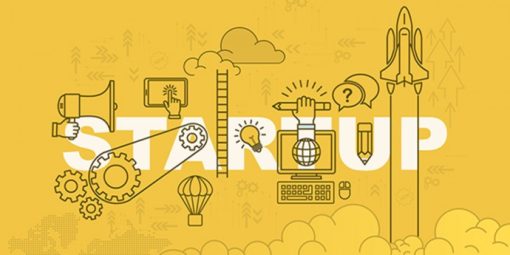
Let me ask you a dumb question: Does your organization produce or provide products or services that customers use? Of course. But maybe a better question would be: how many of you would like to produce them faster or with more innovation?
If you produce new products or services, you potentially could use a Lean Startup approach and create them faster and with more value. It doesn’t matter if you work for a small company, at a major multi-national company like GE (who uses lean startups), or for government or a non-profit. Lean startups are useful and needed in all industries and organizations.
The Lean Startup method was created by Eric Ries and described in his groundbreaking book The Lean Startup[1] back in 2011. I first came across his work a few years after that and it struck me as intuitively sensible. Part of the reason it resonated with me was a few years earlier our company conducted a lean startup type of effort. We built our Online Study Exams product based on customer needs and Ries’ concepts really hit home. They also made we wish I had known then what I know now. So here is a series of 3 articles to help others based on lots of mistakes and learning! It takes the concepts of the Lean Startup process and shows how business analysis techniques support this process.
What we’ll explore in this 3-part series is:
- Part 1 (this article): What are the main principles of the Lean Startup framework so you can see their importance for developing innovative and winning products quickly. I’ll touch on why Agile is a necessary but not sufficient condition to building the right products.
- Part 2: The Lean Startup methodology. This part includes a list of 12 key Business Analysis techniques that are valuable throughout the Lean Startup process and provide needed “fuel” for them.
- Part 3: Explores the “Measure” and “Learn” parts of the methodology, keys to a successful lean startup. There are an additional eight Business Analysis techniques that help these two portions work successfully.
Part 1: What is Lean Startup and why is it needed?
Lean Startup is a “methodology for developing businesses and products, which aims to shorten product development cycles by adopting a combination of business-hypothesis-driven experimentation, iterative product releases, and validated learning.” Wikipedia[2]
The reason we all need to care reflects the state of business today[3]:
- The pressure to innovate or lose market share. In some cases, companies who don’t innovate end up stagnating, like Blackberry, or worst case going out of business, like Blockbuster.
- Innovation is not a black box. You can’t just buy it or demand it.
- Jumping to solutions is as rampant as ever. Executives feel the need to “get going and build something!”
- The need to deliver value and deliver it faster than the competition. For non-profits, this is expressed by the need to deliver value or face reduced funding.
- “The need to focus on what customers want, not just on what we think they want or what they tell us they want.” Ries
- The innovator’s dilemma: adding incremental product improvements is always safer and easier than new breakthrough products. Even Apple has been playing it safe recently by adding small incremental features rather than new, innovative products.
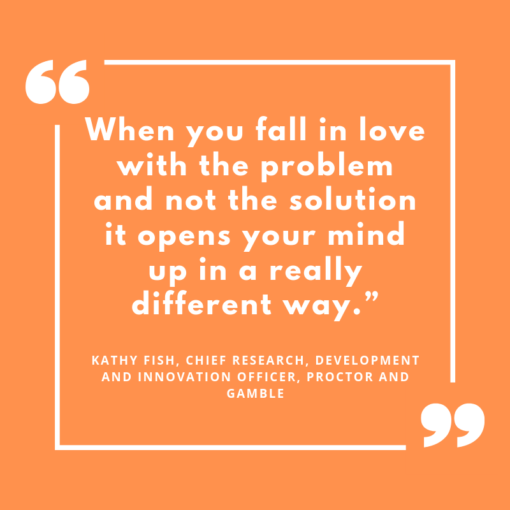
But which solutions does an organization pursue? The key is to define the problem(s) first and use them to figure out what our customers need. Then we can work on solutions. It seems obvious, but that approach is not always followed for a multitude of reasons.
Kathy Fish, the CTO of Proctor and Gamble and a big proponent of Lean Startups, puts it well: “When you fall in love with the problem and not the solution it opens your mind up in a really different way.[4]” Fish goes on to say by following a different funding approach to new products, they are moving faster and spending 25-50 percent less money to boot.
Lean Startups are based on five principles[5], most of which are beyond the scope of this article. We will focus on the Build-Measure-Learn methodology.
- Entrepreneurs are Everywhere
- Entrepreneurship is Management
- Validated Learning
- Innovation Accounting
- Build-Measure-Learn
Lean Startup Methodology
Lean Startup shares its heritage with lean manufacturing. It relies on the knowledge and creativity of individual workers, shrinking of batch sizes, Just-in-Time (JIT) inventory, and faster cycle times. You might recognize the underpinnings of Agile here, too, since they are also based on these principles. Lean Startup borrows from other management and product development ideas as well, including design thinking and customer experience/development.
 All these disciplines share a focus on value, which from a lean perspective is anything that provides benefit to the customer (and not just what we think they want or might want). Plus, they all have an aversion to non-value-added features.
All these disciplines share a focus on value, which from a lean perspective is anything that provides benefit to the customer (and not just what we think they want or might want). Plus, they all have an aversion to non-value-added features.
But, wait, if they are similar, what’s wrong with just using Agile? Well, Agile alone is not enough. It helps you build a product the right way; it doesn’t mean you will build the right product. We need to figure out what the right product is, then use Agile to build it right. Lean Startups help us determine the right products and features.
In The Lean Startup1, Eric Ries describes the methodology for building the “right product.” The basic kernel of what makes Lean Startup work is cycling multiple times through what is called the Build-Measure-Learn (B-M-L) cycle. See Figure 1.
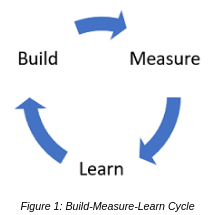
Here’s a typical flow: After building an initial product increment, we measure how it is adopted and used. From those measures, we learn what worked and didn’t and use it for the next cycle. I think it literally flips around the normal cycle of learning what customers need and then building what we think will need. It also promotes innovation since we can incrementally discover what customers truly value and deliver it to them as we learn what is valuable to them.
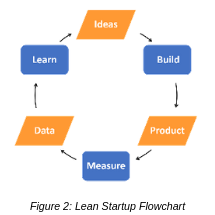
Figure 2 shows the cycle from a flowchart perspective:
- Lean Startups begin with ideas that are used as inputs for what to build. Those ideas are guided by the vision for what the product should achieve.
- A product increment is an output from that and the use or adoption of the product and its features are what is being measured.
- Measurements produce data, which is what we use to learn from.
- The output from learning is new ideas for what to build for the next increment.
The methodology assumes you have identified a problem and have a vision and ideas on how to solve it. From a process standpoint, those are “pre-conditions.” It also relies on having an overall strategy for the product’s direction to support it. Without those, we’d be meandering around a lot instead of focusing on solving particular customer problems. Each time through the B-M-L loop we produce a new product increment. See Figure 3 for a graphical view of this “framework.”’
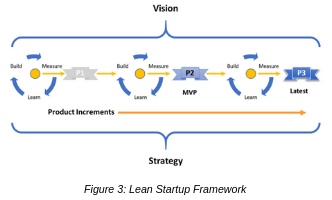
To conclude, Lean Startups give us a simple, repeatable, and rigorous way to build products that customers want and need, not just what they say they want. The core of the method is the Build-Measure-Learn Cycle, which produces product increments that we can measure and use data to learn whether the features are valuable or not. It is more complex, of course, but my aim with this article is to give a practical overview of the methodology.
In Parts 2 and 3, I’ll continue by exploring the B-M-L Cycle further and showing the business analysis techniques that can propel Lean Startups to build creative and effective solutions.
[1] Eric Ries, The Lean Startup: How Today’s Entrepreneurs Use Continuous Innovation to Create Radically Successful Businesses, New York: Crown Business Books, 2011
[2] https://en.wikipedia.org/wiki/Lean_startup
[3] Adapted from Clayton M. Christensen, The Innovator’s Dilemma, New York: Harper Collins, 1997-2011
[4] Downloaded from https://leanstartup.co/how-procter-gamble-uses-lean-startup-to-innovate/, Downloaded Sept. 4, 2018
[5] The Lean Startup, https://theleanstartup.com/principles
Richard Larson, PMP, CBAP, PMI-PBA, was the founder of and is now a consultant for Watermark Learning. He is a successful entrepreneur with over 35 years of experience in product development, business analysis, project management, training, and consulting. As an internal entrepreneur, Rich led the development of several Watermark Learning online products as a business analyst and product owner.
Rich is a frequent speaker at Business Analysis and Project Management national conferences and IIBA® and PMI® chapters around the world. He has contributed as a lead author to the BA Body of Knowledge version 2.0 and 3.0 and was a lead author on PMI’s Business Analysis Practice Guide. He and his wife Elizabeth Larson have co-authored five books on business analysis.
Richard Larson, PMP, CBAP, PMI-PBA
Latest posts by Richard Larson, PMP, CBAP, PMI-PBA (see all)
- What, Me Worried? Five Tips to Improve Study and Comprehension for Passing Business Analysis Certification Exams - June 30, 2020
- A Primer On Working With Executives: Swim With The Sharks Without Getting Eaten Alive - February 18, 2020
- Five Trends in Business Analysis, Project Management, and Agile for 2020 - January 6, 2020

 New Horizons
New Horizons
 Project Management Academy
Project Management Academy
 Six Sigma Online
Six Sigma Online
 Velopi
Velopi
 Watermark Learning
Watermark Learning
 Login
Login




 New Horizons
New Horizons
 Project Management Academy
Project Management Academy
 Velopi
Velopi
 Six Sigma Online
Six Sigma Online
 Watermark Learning
Watermark Learning